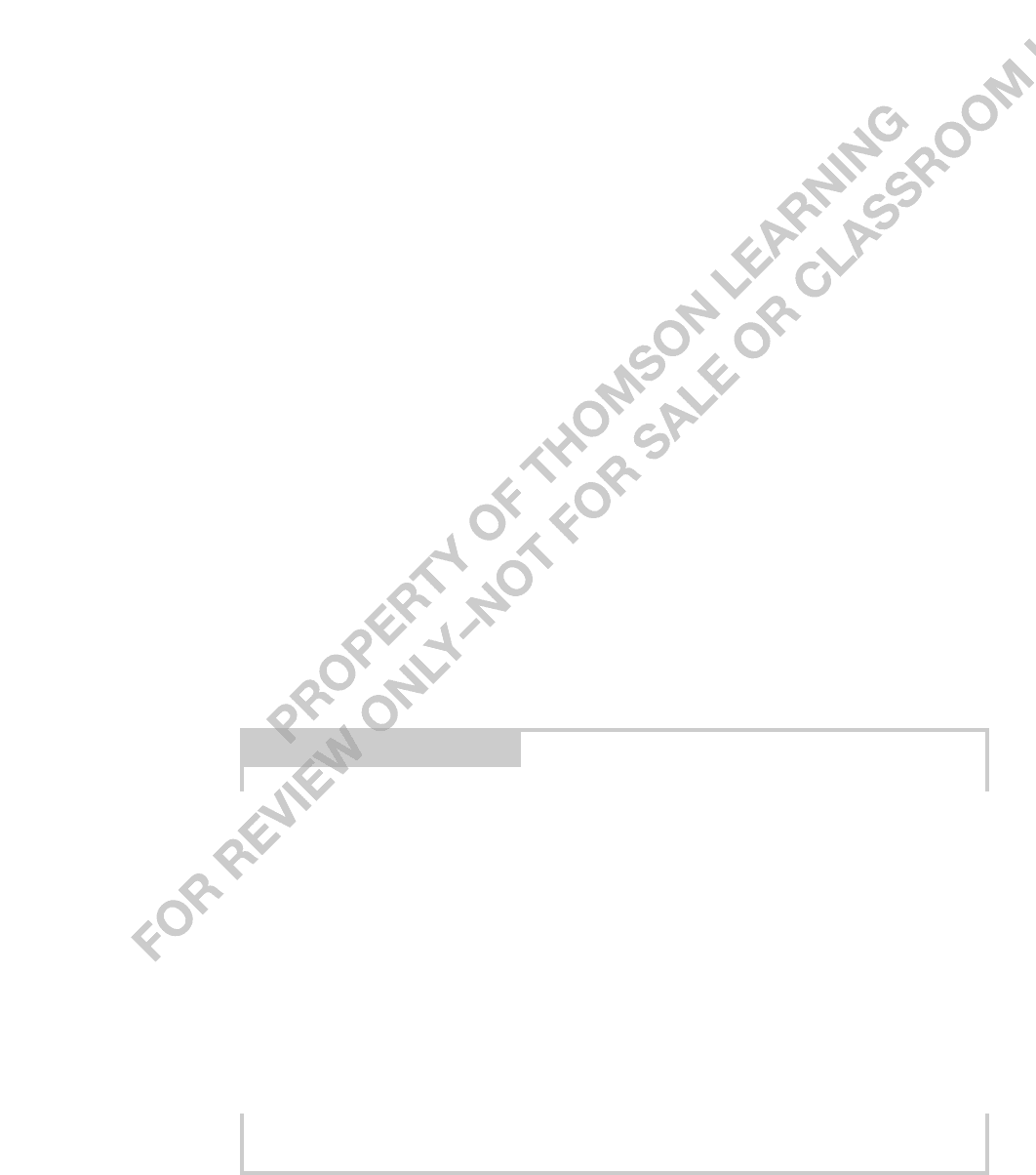Wooldridge J. Introductory Econometrics: A Modern Approach (Basic Text - 3d ed.)
Подождите немного. Документ загружается.


Finally, an R-squared is reported for the PW estimation that is well below the R-squared for
the OLS estimation in this case. However, these R-squareds should not be compared. For OLS,
the R-squared, as usual, is based on the regression with the untransformed dependent and
independent variables. For PW, the R-squared comes from the final regression of the trans-
formed dependent variable on the transformed independent variables. It is not clear what this
R
2
is actually measuring; nevertheless, it is traditionally reported.
Comparing OLS and FGLS
In some applications of the Cochrane-Orcutt or Prais-Winsten methods, the FGLS esti-
mates differ in practically important ways from the OLS estimates. (This was not the case
in Example 12.4.) Typically, this has been interpreted as a verification of feasible GLS’s
superiority over OLS. Unfortunately, things are not so simple. To see why, consider the
regression model
y
t
0
1
x
t
u
t
,
where the time series processes are stationary. Now, assuming that the law of large num-
bers holds, consistency of OLS for
1
holds if
Cov(x
t
,u
t
) 0.
(12.34)
Earlier, we asserted that FGLS was consistent under the strict exogeneity assumption,
which is more restrictive than (12.34). In fact, it can be shown that the weakest assump-
tion that must hold for FGLS to be consistent, in addition to (12.34), is that the sum of
x
t1
and x
t1
is uncorrelated with u
t
:
Cov[(x
t1
x
t1
),u
t
] 0.
(12.35)
Practically speaking, consistency of FGLS requires u
t
to be uncorrelated with x
t1
, x
t
, and
x
t1
.
How can we show that condition (12.35) is needed along with (12.34)? The argument
is simple if we assume
is known and drop the first time period, as in Cochrane-Orcutt.
The argument when we use
ˆ is technically harder and yields no additional insights. Since
one observation cannot affect the asymptotic properties of an estimator, dropping it does
not affect the argument. Now, with known
, the GLS estimator uses x
t
x
t1
as the
regressor in an equation where u
t
u
t1
is the error. From Theorem 11.1, we know the
key condition for consistency of OLS is that the error and the regressor are uncorrelated.
In this case, we need E[(x
t
x
t1
)(u
t
u
t1
)] 0. If we expand the expectation, we get
E[(x
t
x
t1
)(u
t
u
t1
)] E(x
t
u
t
)
E(x
t1
u
t
)
E(x
t
u
t1
)
2
E(x
t1
u
t1
)
[E(x
t1
u
t
) E(x
t
u
t1
)]
because E(x
t
u
t
) E(x
t1
u
t1
) 0 by assumption (12.34). Now, under stationarity, E(x
t
u
t1
)
E(x
t1
u
t
) because we are just shifting the time index one period forward. Therefore,
E(x
t1
u
t
) E(x
t
u
t1
) E[(x
t1
x
t1
)u
t
],
428 Part 2 Regression Analysis with Time Series Data

Chapter 12 Serial Correlation and Heteroskedasticity in Time Series Regressions 429
and the last expectation is the covariance in equation (12.35) because E(u
t
) 0. We have
shown that (12.35) is necessary along with (12.34) for GLS to be consistent for
1
. [Of
course, if
0, we do not need (12.35) because we are back to doing OLS.]
Our derivation shows that OLS and FGLS might give significantly different estimates
because (12.35) fails. In this case, OLS—which is still consistent under (12.34)—is pre-
ferred to FGLS (which is inconsistent). If x has a lagged effect on y, or x
t1
reacts to
changes in u
t
, FGLS can produce misleading results.
Because OLS and FGLS are different estimation procedures, we never expect them
to give the same estimates. If they provide similar estimates of the
j
, then FGLS is pre-
ferred if there is evidence of serial correlation, because the estimator is more efficient
and the FGLS test statistics are at least asymptotically valid. A more difficult problem
arises when there are practical differences in the OLS and FGLS estimates: it is hard to
determine whether such differences are statistically significant. The general method pro-
posed by Hausman (1978) can be used, but it is beyond the scope of this text.
Consistency and asymptotic normality of OLS and FGLS rely heavily on the time
series processes y
t
and the x
tj
being weakly dependent. Strange things can happen if we
apply either OLS or FGLS when some processes have unit roots. We discuss this further
in Chapter 18.
EXAMPLE 12.5
(Static Phillips Curve)
Table 12.2 presents OLS and iterated Prais-Winsten estimates of the static Phillips curve from
Example 10.1, using the observations through 1996.
TABLE 12.2
Dependent Variable: inf
Coefficient OLS Prais-Winsten
unem .468 .716
(.289) (.313)
intercept 1.424 8.296
(1.719) (2.231)
ˆ ——— .781
Observations .49 .49
R-Squared .053 .136
The coefficient of interest is on unem, and it differs markedly between PW and OLS. Because
the PW estimate is consistent with the inflation-unemployment tradeoff, our tendency is to
focus on the PW estimates. In fact, these estimates are fairly close to what is obtained by

first differencing both inf and unem (see Computer Exercise C11.4), which makes sense
because the quasi-differencing used in PW with
ˆ .781 is similar to first differencing. It
may just be that inf and unem are not related in levels, but they have a negative relation-
ship in first differences.
Correcting for Higher Order Serial Correlation
It is also possible to correct for higher orders of serial correlation. A general treatment is
given in Harvey (1990). Here, we illustrate the approach for AR(2) serial correlation:
u
t
1
u
t1
2
u
t2
e
t
,
where {e
t
} satisfies the assumptions stated for the AR(1) model. The stability conditions
are more complicated now. They can be shown to be (see Harvey [1990])
2
1,
2
1
1, and
1
2
1.
For example, the model is stable if
1
.8 and
2
.3; the model is unstable if
1
.7 and
2
.4.
Assuming the stability conditions hold, we can obtain the transformation that elimi-
nates the serial correlation. In the simple regression model, this is easy when t 2:
y
t
1
y
t1
2
y
t2
0
(1
1
2
)
1
(x
t
1
x
t1
2
x
t2
) e
t
or
y˜
t
0
(1
1
2
)
1
x˜
t
e
t
, t 3,4,…,n.
(12.36)
If we know
1
and
2
, we can easily estimate this equation by OLS after obtaining the
transformed variables. Since we rarely know
1
and
2
, we have to estimate them. As usual,
we can use the OLS residuals, uˆ
t
: obtain
ˆ
1
and
ˆ
2
from the regression of
uˆ
t
on uˆ
t1
, uˆ
t2
, t 3,…,n.
[This is the same regression used to test for AR(2) serial correlation with strictly exoge-
nous regressors.] Then, we use
ˆ
1
and
ˆ
2
in place of
1
and
2
to obtain the transformed
variables. This gives one version of the feasible GLS estimator. If we have multiple
explanatory variables, then each one is transformed by x˜
tj
x
tj
ˆ
1
x
t1,j
ˆ
2
x
t2,j
, when
t 2.
The treatment of the first two observations is a little tricky. It can be shown that the
dependent variable and each independent variable (including the intercept) should be
transformed by
z˜
1
{(1
2
)[(1
2
)
2
1
2
]/(1
2
)}
1/2
z
1
z˜
2
(1
2
2
)
1/2
z
2
[
1
(1
1
2
)
1/2
/(1
2
)]z
1
,
where z
1
and z
2
denote either the dependent or an independent variable at t 1 and t
2, respectively. We will not derive these transformations. Briefly, they eliminate the serial
correlation between the first two observations and make their error variances equal to
e
2
.
430 Part 2 Regression Analysis with Time Series Data

Fortunately, econometrics packages geared toward time series analysis easily estimate
models with general AR(q) errors; we rarely need to directly compute the transformed
variables ourselves.
12.4 Differencing and Serial Correlation
In Chapter 11, we presented differencing as a transformation for making an integrated
process weakly dependent. There is another way to see the merits of differencing when
dealing with highly persistent data. Suppose that we start with the simple regression
model:
y
t
0
1
x
t
u
t
, t 1,2,…, (12.37)
where u
t
follows the AR(1) process in (12.26). As we mentioned in Section 11.3, and as
we will discuss more fully in Chapter 18, the usual OLS inference procedures can be very
misleading when the variables y
t
and x
t
are integrated of order one, or I(1). In the extreme
case where the errors {u
t
} in (12.37) follow a random walk, the equation makes no sense
because, among other things, the variance of u
t
grows with t. It is more logical to differ-
ence the equation:
y
t
1
x
t
u
t
, t 2,…,n. (12.38)
If u
t
follows a random walk, then e
t
u
t
has zero mean and a constant variance and is
serially uncorrelated. Thus, assuming that e
t
and x
t
are uncorrelated, we can estimate
(12.38) by OLS, where we lose the first observation.
Even if u
t
does not follow a random walk, but
is positive and large, first differenc-
ing is often a good idea: it will eliminate most of the serial correlation. Of course, (12.38)
is different from (12.37), but at least we can have more faith in the OLS standard errors
and t statistics in (12.38). Allowing for multiple explanatory variables does not change
anything.
EXAMPLE 12.6
(Differencing the Interest Rate Equation)
In Example 10.2, we estimated an equation relating the three-month T-bill rate to inflation and
the federal deficit [see equation (10.15)]. If we regress the residuals from this equation on a
single lag, we obtain
ˆ .530 (.123), which is statistically greater than zero. If we difference
i3, inf, and def and then check the residuals for AR(1) serial correlation, we obtain
ˆ .068 (.145), so there is no evidence of serial correlation. The differencing has apparently
eliminated any serial correlation. [In addition, there is evidence that i3 contains a unit root, and
inf may as well, so differencing might be needed to produce I(0) variables anyway.]
Chapter 12 Serial Correlation and Heteroskedasticity in Time Series Regressions 431

As we explained in Chapter 11, the
decision of whether or not to difference is
a tough one. But this discussion points out
another benefit of differencing, which is
that it removes serial correlation. We will
come back to this issue in Chapter 18.
12.5 Serial Correlation-Robust
Inference after OLS
In recent years, it has become more popular to estimate models by OLS but to correct the
standard errors for fairly arbitrary forms of serial correlation (and heteroskedasticity). Even
though we know OLS will be inefficient, there are some good reasons for taking this
approach. First, the explanatory variables may not be strictly exogenous. In this case, FGLS
is not even consistent, let alone efficient. Second, in most applications of FGLS, the errors
are assumed to follow an AR(1) model. It may be better to compute standard errors for the
OLS estimates that are robust to more general forms of serial correlation.
To get the idea, consider equation (12.4), which is the variance of the OLS slope esti-
mator in a simple regression model with AR(1) errors. We can estimate this variance very
simply by plugging in our standard estimators of
and
2
. The only problems with this
are that it assumes the AR(1) model holds and also assumes homoskedasticity. It is pos-
sible to relax both of these assumptions.
A general treatment of standard errors that are both heteroskedasticity- and serial
correlation-robust is given in Davidson and MacKinnon (1993). Here, we provide a sim-
ple method to compute the robust standard error of any OLS coefficient.
Our treatment here follows Wooldridge (1989). Consider the standard multiple linear
regression model
y
t
0
1
x
t1
…
k
x
tk
u
t
, t1,2,…,n, (12.39)
which we have estimated by OLS. For concreteness, we are interested in obtaining a serial
correlation-robust standard error for
ˆ
1
. This turns out to be fairly easy. Write x
t1
as a lin-
ear function of the remaining independent variables and an error term,
x
t1
0
2
x
t2
…
k
x
tk
r
t
, (12.40)
where the error r
t
has zero mean and is uncorrelated with x
t2
,x
t3
,…,x
tk
.
Then, it can be shown that the asymptotic variance of the OLS estimator
ˆ
1
is
Avar(
ˆ
1
)
n
t1
E(r
t
2
)
2
Var
n
t1
r
t
u
t
.
Under the no serial correlation Assumption TS.5,{a
t
r
t
u
t
} is serially uncorrelated, so
either the usual OLS standard errors (under homoskedasticity) or the heteroskedasticity-
robust standard errors will be valid. But if TS.5 fails, our expression for Avar(
ˆ
1
) must
432 Part 2 Regression Analysis with Time Series Data
Suppose after estimating a model by OLS that you estimate
from
regression (12.14) and you obtain
ˆ .92. What would you do
about this?
QUESTION 12.4

account for the correlation between a
t
and a
s
,when t s. In practice, it is common to
assume that, once the terms are farther apart than a few periods, the correlation is essen-
tially zero. Remember that under weak dependence, the correlation must be approaching
zero, so this is a reasonable approach.
Following the general framework of Newey and West (1987), Wooldridge (1989)
shows that Avar(
ˆ
1
) can be estimated as follows. Let “se(
ˆ
1
)” denote the usual (but incor-
rect) OLS standard error and let
ˆ be the usual standard error of the regression (or root
mean squared error) from estimating (12.39) by OLS. Let rˆ
t
denote the residuals from the
auxiliary regression of
x
t1
on x
t2
,x
t3
,…,x
tk
(12.41)
(including a constant, as usual). For a chosen integer g 0, define
v
ˆ
n
t1
a
ˆ
t
2
2
g
h1
[1 h/(g 1)]
n
th1
a
ˆ
t
a
ˆ
th
,
(12.42)
where
a
ˆ
t
r
ˆ
t
u
ˆ
t
, t 1,2,…,n.
This looks somewhat complicated, but in practice it is easy to obtain. The integer g in
(12.42) controls how much serial correlation we are allowing in computing the standard
error. Once we have v
ˆ,
the serial correlation-robust standard error of
ˆ
1
is simply
se(
ˆ
1
) [“se(
ˆ
1
)”/
ˆ
]
2
v
ˆ
.
(12.43)
In other words, we take the usual OLS standard error of
ˆ
1
,divide it by
ˆ, square the
result, and then multiply by the square root of v
ˆ
. This can be used to construct confidence
intervals and t statistics for
ˆ
1
.
It is useful to see what v
ˆ
looks like in some simple cases. When g 1,
v
ˆ
n
t1
a
ˆ
t
2
n
t2
a
ˆ
t
a
ˆ
t1
,
(12.44)
and when g 2,
v
ˆ
n
t1
a
ˆ
t
2
(4/3)
n
t2
a
ˆ
t
a
ˆ
t1
(2/3)
n
t3
a
ˆ
t
a
ˆ
t2
.
(12.45)
The larger that g is, the more terms are included to correct for serial correlation. The pur-
pose of the factor [1 h/(g 1)] in (12.42) is to ensure that v
ˆ
is in fact nonnegative
(Newey and West [1987] verify this). We clearly need v
ˆ
0, since v
ˆ
is estimating a vari-
ance and the square root of v
ˆ
appears in (12.43).
Chapter 12 Serial Correlation and Heteroskedasticity in Time Series Regressions 433

The standard error in (12.43) is also robust to arbitrary heteroskedasticity. (In the time
series literature, the serial correlation-robust standard errors are sometimes called het-
eroskedasticity and autocorrelation consistent, or HAC, standard errors.) In fact, if we
drop the second term in (12.42), then (12.43) becomes the usual heteroskedasticity-robust
standard error that we discussed in Chapter 8 (without the degrees of freedom adjustment).
The theory underlying the standard error in (12.43) is technical and somewhat subtle.
Remember, we started off by claiming we do not know the form of serial correlation. If
this is the case, how can we select the integer g? Theory states that (12.43) works for fairly
arbitrary forms of serial correlation, provided g grows with sample size n. The idea is that,
with larger sample sizes, we can be more flexible about the amount of correlation in (12.42).
There has been much recent work on the relationship between g and n,but we will not go
into that here. For annual data, choosing a small g, such as g 1 or g 2, is likely to
account for most of the serial correlation. For quarterly or monthly data, g should proba-
bly be larger (such as g 4 or 8 for quarterly and g 12 or 24 for monthly), assuming
that we have enough data. Newey and West (1987) recommend taking g to be the integer
part of 4(n/100)
2/9
; others have suggested the integer part of n
1/4
. The Newey-West sug-
gestion is implemented by the econometrics program Eviews
®
. For, say, n 50 (which is
reasonable for annual, postwar data from World War II), g 3. (The integer part of n
1/4
gives g 2.)
We summarize how to obtain a serial correlation-robust standard error for
ˆ
1
. Of
course, since we can list any independent variable first, the following procedure works for
computing a standard error for any slope coefficient.
SERIAL CORRELATION-ROBUST STANDARD ERROR FOR B
ˆ
1
:
(i) Estimate (12.39) by OLS, which yields “se(
ˆ
1
)”,
ˆ, and the OLS residuals
{uˆ
t
: t 1,…,n}.
(ii) Compute the residuals {r
ˆ
t
: t 1,…,n} from the auxiliary regression (12.41). Then,
form a
ˆ
t
r
ˆ
t
u
ˆ
t
(for each t).
(iii) For your choice of g, compute v
ˆ
as in (12.42).
(iv) Compute se(
ˆ
1
) from (12.43).
Empirically, the serial correlation-robust standard errors are typically larger than the
usual OLS standard errors when there is serial correlation. This is true because, in most
cases, the errors are positively serially correlated. However, it is possible to have substan-
tial serial correlation in {u
t
} but to also have similarities in the usual and serial correlation-
robust (SC-robust) standard errors of some coefficients: it is the sample autocorrelations of
a
ˆ
t
r
ˆ
t
u
ˆ
t
that determine the robust standard error for
ˆ
1
.
The use of SC-robust standard errors has lagged behind the use of standard errors
robust only to heteroskedasticity for several reasons. First, large cross sections, where the
heteroskedasticity-robust standard errors will have good properties, are more common than
large time series. The SC-robust standard errors can be poorly behaved when there is sub-
stantial serial correlation and the sample size is small (where small can even be as large as,
say, 100). Second, since we must choose the integer g in equation (12.42), computation of
the SC-robust standard errors is not automatic. As mentioned earlier, some econometrics
packages have automated the selection, but you still have to abide by the choice.
434 Part 2 Regression Analysis with Time Series Data

Another important reason that SC-robust standard errors are not yet routinely com-
puted is that, in the presence of severe serial correlation, OLS can be very inefficient,
especially in small sample sizes. After performing OLS and correcting the standard
errors for serial correlation, the coefficients are often insignificant, or at least less sig-
nificant than they were with the usual OLS standard errors.
If we are confident that the explanatory variables are strictly exogenous, yet are skep-
tical about the errors following an AR(1) process, we can still get estimators more efficient
than OLS by using a standard feasible GLS estimator, such as Prais-Winsten or Cochrane-
Orcutt. With substantial serial correlation, the quasi-differencing transformation used by
PW and CO is likely to be better than doing nothing and just using OLS. But, if the errors
do not follow an AR(1) model, then the standard errors reported from PW or CO estima-
tion will be incorrect. Nevertheless, we can manually quasi-difference the data after estimat-
ing r, use pooled OLS on the transformed data, and then use SC-robust standard errors in
the transformed equation. Computing an SC-robust standard error after quasi-differencing
would ensure that any extra serial correlation is accounted for in statistical inference. In
fact, the SC-robust standard errors probably work better after much serial correlation has
been eliminated using quasi-differencing [or some other transformation, such as that used
for AR(2) serial correlation]. Such an approach is analogous to using weighted least squares
in the presence of heteroskedasticity but then computing standard errors that are robust to
having the variance function incorrectly specified; see Section 8.4.
The SC-robust standard errors after OLS estimation are most useful when we have
doubts about some of the explanatory variables being strictly exogenous, so that meth-
ods such as Prais-Winsten and Cochrane-Orcutt are not even consistent. It is also valid
to use the SC-robust standard errors in models with lagged dependent variables, assum-
ing, of course, that there is good reason for allowing serial correlation in such models.
EXAMPLE 12.7
(The Puerto Rican Minimum Wage)
We obtain an SC-robust standard error for the minimum wage effect in the Puerto Rican
employment equation. In Example 12.2, we found pretty strong evidence of AR(1) serial cor-
relation. As in that example, we use as additional controls log(usgnp), log(prgnp), and a lin-
ear time trend.
The OLS estimate of the elasticity of the employment rate with respect to the minimum
wage is
ˆ
1
.2123, and the usual OLS standard error is “se(
ˆ
1
)” .0402. The standard
error of the regression is
ˆ
.0328. Further, using the previous procedure with g 2 [see
(12.45)], we obtain v
ˆ
.000805. This gives the SC/heteroskedasticity-robust standard error
as se(
ˆ
1
) [(.0402/.0328)
2
]
.000805 .0426. Interestingly, the robust standard error is only
slightly greater than the usual OLS standard error. The robust t statistic is about 4.98, and
so the estimated elasticity is still very statistically significant.
For comparison, the iterated PW estimate of
1
is .1477, with a standard error of .0458.
Thus, the FGLS estimate is closer to zero than the OLS estimate, and we might suspect viola-
tion of the strict exogeneity assumption. Or, the difference in the OLS and FGLS estimates
might be explainable by sampling error. It is very difficult to tell.
Chapter 12 Serial Correlation and Heteroskedasticity in Time Series Regressions 435

Before leaving this section, we note that it is possible to construct serial correlation-
robust, F-type statistics for testing multiple hypotheses, but these are too advanced to cover
here. (See Wooldridge [1991b, 1995] and Davidson and MacKinnon [1993] for treatments.)
12.6 Heteroskedasticity in Time Series Regressions
We discussed testing and correcting for heteroskedasticity for cross-sectional applications
in Chapter 8. Heteroskedasticity can also occur in time series regression models, and the
presence of heteroskedasticity, while not causing bias or inconsistency in the
ˆ
j
, does
invalidate the usual standard errors, t statistics, and F statistics. This is just as in the cross-
sectional case.
In time series regression applications, heteroskedasticity often receives little, if any,
attention: the problem of serially correlated errors is usually more pressing. Nevertheless,
it is useful to briefly cover some of the issues that arise in applying tests and corrections
for heteroskedasticity in time series regressions.
Because the usual OLS statistics are asymptotically valid under Assumptions TS.1
through TS.5,we are interested in what happens when the homoskedasticity assumption,
TS.4, does not hold. Assumption TS.3 rules out misspecifications such as omitted vari-
ables and certain kinds of measurement error, while TS.5 rules out serial correlation in
the errors. It is important to remember that serially correlated errors cause problems that
adjustments for heteroskedasticity are not able to address.
Heteroskedasticity-Robust Statistics
In studying heteroskedasticity for cross-sectional regressions, we noted how it has no bear-
ing on the unbiasedness or consistency of the OLS estimators. Exactly the same conclu-
sions hold in the time series case, as we can see by reviewing the assumptions needed for
unbiasedness (Theorem 10.1) and consistency (Theorem 11.1).
In Section 8.2, we discussed how the usual OLS standard errors, t statistics, and F sta-
tistics can be adjusted to allow for the presence of heteroskedasticity of unknown form.
These same adjustments work for time series regressions under Assumptions TS.1,TS.2,
TS.3, and TS.5. Thus, provided the only assumption violated is the homoskedasticity
assumption, valid inference is easily obtained in most econometric packages.
Testing for Heteroskedasticity
Sometimes, we wish to test for heteroskedasticity in time series regressions, especially
if we are concerned about the performance of heteroskedasticity-robust statistics in rel-
atively small sample sizes. The tests we covered in Chapter 8 can be applied directly, but
with a few caveats. First, the errors u
t
should not be serially correlated; any serial corre-
lation will generally invalidate a test for heteroskedasticity. Thus, it makes sense to test
for serial correlation first, using a heteroskedasticity-robust test if heteroskedasticity is
suspected. Then, after something has been done to correct for serial correlation, we can
test for heteroskedasticity.
436 Part 2 Regression Analysis with Time Series Data

Second, consider the equation used to motivate the Breusch-Pagan test for het-
eroskedasticity:
u
t
2
0
1
x
t1
…
k
x
tk
v
t
, (12.46)
where the null hypothesis is H
0
:
1
2
…
k
0. For the F statistic—with uˆ
t
2
replacing u
t
2
as the dependent variable—to be valid, we must assume that the errors {v
t
}
are themselves homoskedastic (as in the cross-sectional case) and serially uncorrelated.
These are implicitly assumed in computing all standard tests for heteroskedasticity, includ-
ing the version of the White test we cov-
ered in Section 8.3. Assuming that the {v
t
}
are serially uncorrelated rules out certain
forms of dynamic heteroskedasticity, some-
thing we will treat in the next subsection.
If heteroskedasticity is found in the u
t
(and the u
t
are not serially correlated), then the
heteroskedasticity-robust test statistics can be used. An alternative is to use weighted least
squares, as in Section 8.4. The mechanics of weighted least squares for the time series
case are identical to those for the cross-sectional case.
EXAMPLE 12.8
(Heteroskedasticity and the Efficient Markets Hypothesis)
In Example 11.4, we estimated the simple model
return
t
0
1
return
t1
u
t
. (12.47)
The EMH states that
1
0. When we tested this hypothesis using the data in NYSE.RAW,
we obtained t
1
1.55 with n 689. With such a large sample, this is not much evidence
against the EMH. Although the EMH states that the expected return given past observable
information should be constant, it says nothing about the conditional variance. In fact, the
Breusch-Pagan test for heteroskedasticity entails regressing the squared OLS residuals u
ˆ
t
2
on
return
t1
:
u
ˆ
t
2
4.66 1.104 return
t1
residual
t
(0.43) (0.201)
n 689, R
2
.042.
(12.48)
The t statistic on return
t1
is about 5.5, indicating strong evidence of heteroskedasticity.
Because the coefficient on return
t1
is negative, we have the interesting finding that volatility
in stock returns is lower when the previous return was high, and vice versa. Therefore, we
have found what is common in many financial studies: the expected value of stock returns
does not depend on past returns, but the variance of returns does.
Chapter 12 Serial Correlation and Heteroskedasticity in Time Series Regressions 437
How would you compute the White test for heteroskedasticity in
equation (12.47)?
QUESTION 12.5
